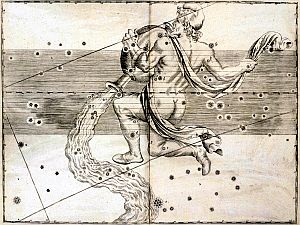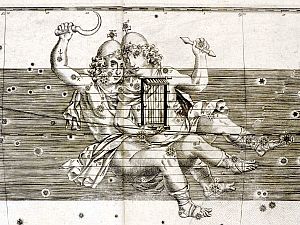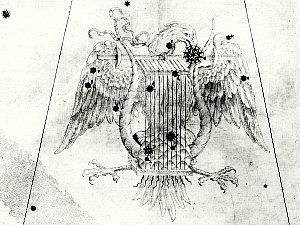Uranometria, published in Augsburg, Germany in 1603 was the first star atlas showing the entire sky.

The atlas contained two overview charts for the northern and the southern hemisphere, 48 charts for each of
Ptolemy's constellations and one chart for the twelve
new constellations reported by Keyser and de Houtman.

Uranometria is derived from the Greek words for sky and measuring. Uranometry means "measuring the sky." The full title of the Atlas is
Uranometria : omnium asterismorum continens schemata, nova methodo delineata, aereis laminis expressa, meaning Uranometria, containing charts
of all the constellations.

The star charts were designed by by German cartographer
Johann Bayer, based on De Mundi Aetherei,
a star catalogue developed by Tycho Brahe's and published in 1602 - just a year prior
to Uranometria.

The charts are true pieces of art, engraved on copper plates by German engraver Alexander Mair.

ETH Zurich and atlascoelestis.com have
the complete collection of the original copperplate engravings. The pictures on this site are taken from the public domain of
Wikimedia.

Sources: Wikipedia, Ian Ridpath
Some of the thumbnail images show enlarged details.
Click on the pictures for complete, larger images. |
|
 Northern Hemisphere
Northern Hemisphere

 Southern Hemisphere
Southern Hemisphere
|













 Northern Hemisphere
Northern Hemisphere

 Aquarius (Amphora)
Aquarius (Amphora) Aquila & Antinous
Aquila & Antinous Ara
Ara

 Aries
Aries Argo Navis
Argo Navis Auriga
Auriga

 Bo÷tes
Bo÷tes Cancer
Cancer Canis Major
Canis Major

 Canis Minor
Canis Minor Capricornus
Capricornus Centaurus, Crux
Centaurus, Crux

 Cassiopeia
Cassiopeia Cepheus
Cepheus Equuleus (Equus Minor)
Equuleus (Equus Minor) Virgo
Virgo

 Cetus
Cetus Corona Australis (Corona Meridionalis)
Corona Australis (Corona Meridionalis) Corona Borealis (Corona Septemtrionalis)
Corona Borealis (Corona Septemtrionalis)

 Corvus
Corvus Crater
Crater Cygnus (Olor)
Cygnus (Olor)

 Delphinus
Delphinus Draco
Draco Eridanus
Eridanus

 Gemini
Gemini Hercules
Hercules Hydra
Hydra

 Leo
Leo Lepus
Lepus Libra
Libra

 Lupus
Lupus Lyra
Lyra Ophiuchus (Serpentarius)
Ophiuchus (Serpentarius)

 Orion
Orion
 Pegasus
Pegasus Perseus
Perseus
 Pisces
Pisces
 Piscis Austrinus (Piscis Notus)
Piscis Austrinus (Piscis Notus) Sagitta
Sagitta
 Sagittarius (Arcitenens)
Sagittarius (Arcitenens)
 Scorpius
Scorpius Serpens
Serpens
 Taurus
Taurus Triangulum
Triangulum Ursa Major
Ursa Major







